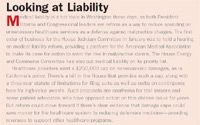New Tools Track Safety, Value in Medicine
FDA's Sentinel Initiative raises broader questions about tapping patient information and health IT for comparative studies in drug development
The process for establishing an active drug safety surveillance system that can quickly detect and assess adverse events is emerging as a model for tapping third-party data to develop information on the performance of medical products and healthcare delivery. In demonstrating ways to link and analyze different data sources, FDA's emerging Sentinel System may be a "national resource for evidence development," says Mark McClellan, former FDA commissioner, now director of the Brookings Institute's Engelberg Center for Healthcare Reform.

Jill Wechsler
Establishing Sentinel, as required by the FDA Amendments Act of 2007 (FDAAA), is a complex undertaking that involves linking up diverse databases and establishing standard analytical methods for evaluating safety signals. As a distributed network, Sentinel leaves patient health information with the data holders, an approach designed to ensure the privacy and security of personal health information. This approach now appears to have uses beyond safety surveillance—for comparative effectiveness research (CER), assessing quality of care, and supporting drug development by identifying patients for clinical trials and evaluating biomarkers.
New Claims Database
Leaders of the Sentinel Initiative discussed its larger impact at a January workshop organized by Brookings as well as at the Drug Information Association's pharmacovigilance conference. Rachel Behrman, associate director for medical policy in the Center for Drug Evaluation and Research (CDER), noted that FDA's collaborative experience with Sentinel may influence the shape of similar initiatives by other government agencies.
For example, the Department of Health and Human Services (HHS) is building a multipayer claims database (MPCD) to support comparative effectiveness research, as authorized and funded by the economic stimulus legislation of 2009. The plan is to build a "hybrid" system with a centralized administrative database on some 100 million individuals in Medicare and other health plans, plus a parallel distributed network component, similar to Sentinel, that can tap additional patient information held by health plans.
The HHS project also may incorporate data from states that have established their own MPCDs, primarily as cost-control strategies. About a dozen state initiatives are analyzing eligibility and claims data to track healthcare use and quality, and to uncover fraud and waste.
These systems currently tap into administrative and claims data, but the plan is to add clinical data in the future, at least for some patient cohorts. For now, Sentinel data partners may be asked to provide certain patient-level information if needed to confirm unclear findings, with that data stripped of patient identifiers before transmission.
Ultimately, a national interoperable electronic medical records system will feed patient-level information into all these information systems. With appropriate privacy protections, this will facilitate assessments of healthcare delivery, support biomedical research, and track medical care for many purposes. But because a comprehensive e-health system is still years away, HHS and FDA will continue to build systems that can assess specific healthcare issues through third-party data banks.
At the Brookings workshop, HHS assistant secretary for policy and evaluation Sherry Glied emphasized the need to coordinate the MCPD project with Sentinel, and CDER director Janet Woodcock similarly suggested that it's important to avoid "reinventing the wheel" with each initiative. Woodcock acknowledged that Sentinel is part of a broader effort to better use data to improve healthcare, and FDA, she said, "is willing to be a node" on these larger e-health information operations.
UnitedHealth Group medical affairs chief Reed Tuckson echoed those remarks, noting that health plans are receiving hundreds of requests for data from federal, state, intrastate, and demonstration projects. Tuckson agreed that these data initiatives can help improve healthcare and product safety, but noted that "data is expensive," and meeting all the requests costs a lot of money.
Mini-Pilot
As a prelude to a fully operational real-time Sentinel System, FDA has established a mini Sentinel pilot to test scientific methodologies for investigating drug use issues, explained Judy Racoosin, CDER's scientific lead for Sentinel. A main goal set by FDAAA is to access data on at least 100 million individuals by July 1, 2012, building on its success in tapping into drug use information on more than 25 million patients seen last July (see Pharm Exec, March 2010). FDA also has formed a drug surveillance collaboration with other federal agencies, including the Centers for Medicaid and Medicare Services, the Veterans Administration, and the Department of Defense, to query these health data banks on safety issues of mutual interest.

Over the past three years, Sentinel has established basic principles and policies, including a Common Data Model, core safety surveillance methods, and Health Outcomes of Interest (HOIs) that deserve evaluation. A Sentinel Coordinating Center operated by Richard Platt of the Harvard Pilgrim Healthcare Institute can send out queries to databases operated by Kaiser Permanente, WellPoint, and the HMO Research Network, among others, and then evaluate resulting responses. Because the Sentinel Initiative involves public health operations, as opposed to research, its query-and-analysis process can proceed without waiting for institutional review board approval.
Benchmarking REMS
Sentinel will test several key protocols this year. One project will assess whether certain postmarketing regulatory initiatives such as REMS (risk evaluation and mitigation strategies) enhance the safe use of medicines. An active surveillance project is monitoring certain outcomes associated with rotavirus and human papillomavirus vaccines. An important study will examine cardio events in users of diabetes drugs by comparing the incidence of myocardial infarction in patients prescribed saxagliptin (Bristol-Myers Squibb's Onglyza) to those taking other diabetes treatments.
The importance of building a solid methodological foundation for interpreting results also was discussed at a symposium sponsored by the Observational Medical Outcomes Partnership (OMOP), a collaboration of industry, FDA, and the Foundation for the NIH (FNIH). OMOP is examining how well different methods and data sources can identify valid safety signals and whether meaningful information can be gleaned from disparate observational data sources that use varying terminologies. The program has identified ways to assess the strength of associations between drug exposure and specific adverse events, such as liver failure or bleeding, and is examining the impact of missing patient information and how well alternative study designs can deal with variations in patient demographics, comorbidities, and drug exposures.
OMOP's success in identifying methods and tools through an open, collaborative process has prompted the participants to extend the partnership beyond its initial two-year time frame. The group also plans to expand into methods that could apply to medical devices and biologics, in addition to drugs, and to assess approaches for CER and healthcare quality measures.
Going Public
As Sentinel moves forward, sponsors and researchers are looking at the broader implications of dealing with early drug safety signals in ways to avoid alarming the public. The mini Sentinel study on diabetes treatments and cardiac events, for example, raises questions about when and how FDA will make public any findings, noted GlaxoSmithKline general counsel Daniel Troy at the Sentinel workshop. Even if FDA says it won't release early results prior to full analysis, outside lawyers and policymakers may try to compel disclosure, which could lead to liability for failure to warn. This applies not just to pharma companies, but also to data partners that hold safety information in their systems, Troy pointed out.
Behrman acknowledged that liability is very much on the agency's mind because it could drive companies away from the Sentinel project. Realistic expectations about what an active drug surveillance system can do is important, said Troy. Sentinel is not the "be-all and end-all" information system, and FDA needs to make it clear to the public that Sentinel signals are based on observational data, which has limitations in making informed judgments about medical safety issues.
Jill Wechsler is Pharmaceutical Executive's Washington correspondent. She can be reached at jwechsler@advanstar.com

FDA Grants Priority Review to Regeneron’s Eylea for Macular Edema Following Retinal Vein Occlusion
April 18th 2025Regulatory action was based on data from the Phase III QUASAR trial, which demonstrated that Eylea HD dosed every eight weeks achieved non-inferior visual acuity outcomes compared to Eylea in patients with macular edema following retinal vein occlusion.
Navigating Distrust: Pharma in the Age of Social Media
February 18th 2025Ian Baer, Founder and CEO of Sooth, discusses how the growing distrust in social media will impact industry marketing strategies and the relationships between pharmaceutical companies and the patients they aim to serve. He also explains dark social, how to combat misinformation, closing the trust gap, and more.
















